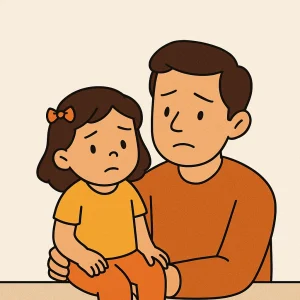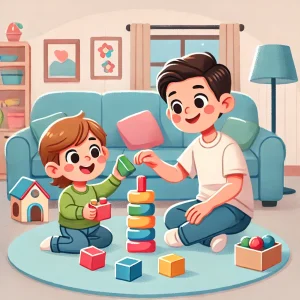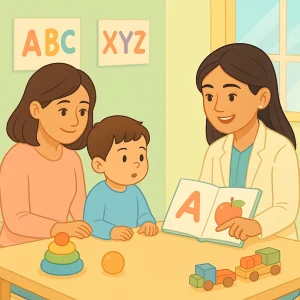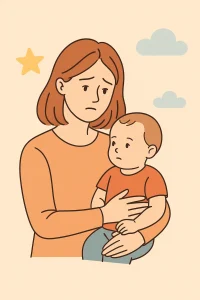Autism and Stuttering: Strategies for Effective Communication
By Rajini D
Last Updated: January 27, 2024
Welcome to a journey of understanding and empathy. Today, we’re delving into a world that’s both unique and challenging – the world of stuttering in autistic children. Each child’s story is distinct, a tapestry woven with threads of resilience, complexity, and hope. Autism Spectrum Disorder (ASD) is a diverse condition, and when it intersects with stuttering, the tapestry becomes even more intricate.
Stuttering, a speech disfluency that affects the fluency and flow of speech, can be a significant hurdle for any child. But for a child with autism, who may already face communication challenges, stuttering can add another layer to their daily struggles. It’s not just about the repetition of sounds or words; it’s about the impact on their ability to express themselves and connect with others.
Also Read: History of Autism: Unraveling Autism’s History
Understanding the Intersection of Autism and Stuttering
Stuttering is like a puzzle, with its pieces fitting uniquely for each individual. Commonly, it manifests as repetitions, prolongations, or blocks in speech. Imagine a child trying to say “butterfly” but getting stuck on the ‘b’ sound or stretching the ‘u’ longer than usual. This can be frustrating and disheartening for any child, but what about children with Autism Spectrum Disorder (ASD)?
ASD itself is a complex puzzle. It’s a developmental disorder that affects communication and behavior. Children with ASD might have difficulties in social interaction, exhibit repetitive behaviors, and show varying levels of speech and nonverbal communication skills. They’re often in a world where communication pathways are distinct from what we typically expect.
When the worlds of autism and stuttering collide, the challenges multiply. A child with ASD might already find social interaction and communication difficult. Add stuttering to the mix, and expressing themselves becomes an even steeper mountain to climb. It’s not just about the physical aspect of speech. It’s about how this intersection affects their confidence and their ability to make friends and share their thoughts and feelings.
Identifying Stuttering in Children with Autism
Spotting stuttering in a child with autism is like looking for a specific star in the night sky. It requires keen observation and understanding. In autistic children, signs of stuttering might be masked by other characteristics of their autism or even overlooked as a part of their developmental journey.
A child with ASD might repeat certain words or phrases, but is this their way of communicating effectively in their world, or is it stuttering? They may pause frequently or use fillers like “um” and “ah,” common in many children but possibly more pronounced in those with ASD.
Diagnosing stuttering in children with ASD is particularly challenging. The overlapping symptoms can blur the lines, making it hard to discern whether speech disruptions are due to stuttering or the characteristics of autism. This is where the expertise of speech therapists, like those at WellnessHub, becomes invaluable. They bring a discerning eye to each child’s unique speech patterns, understanding the nuanced differences.
As one speech therapist at WellnessHub insightfully puts it, “In the tapestry of a child’s speech, every thread of sound and silence has its place and meaning. Our role is to understand and untangle these threads, giving voice to the little ones struggling to express themselves.”
Also Read: Early Identification/ Warning Signs in child development
Emotional and Social Implications
The journey of a child with autism and stuttering is not just about navigating the complexities of speech. It’s a journey filled with emotional and social nuances that shape their world in profound ways.
Imagine a playground where children chatter and play. In the midst of this, there’s a child with autism and stuttering, struggling to join in. Each attempt to speak might be met with pauses or repetitions, causing frustration and confusion not only for the child but also for their peers. The emotional impact here is twofold – the child feels isolated, unable to express their thoughts and feelings, and their peers, uncertain of how to respond, might withdraw or react negatively.
Anecdotes from families reveal the heart of these experiences. A mother shared, “When my son tries to tell a story and gets stuck on a word, I see the light in his eyes dim. It’s not just about speaking. It’s about sharing his world with us.” These stories remind us that behind each struggle with stuttering and autism, there’s a child longing to connect, to be heard, and to be understood.
This is where understanding and patience from family and peers become vital. Creating an environment of acceptance, where efforts to communicate are met with kindness and encouragement, can significantly alleviate the emotional burden these children face. It’s about listening to our hearts, giving them time and space to express themselves in their own unique way.
Read our article on The Early Years: Emotional and mental health is a concern for kids below five years
Speech Therapy and Intervention Strategies
Speech therapy for children with autism and stuttering is not a one-size-fits-all solution; it’s a tailored approach that evolves with each child’s unique needs. Effective speech therapy techniques often involve a blend of strategies designed to improve fluency, enhance communication skills, and build confidence.
For children with autism and stuttering, therapy might include activities that focus on slowing down speech, using visual aids to facilitate communication, or exercises that reduce the tension associated with stuttering. Techniques such as ‘easy onset’ and ‘light contact’ can also be helpful. These methods are not just about enhancing speech fluency; they’re about empowering children to communicate more effectively in their daily lives.
The role of parents and caregivers in this process is immeasurable. Their involvement in therapy, consistent reinforcement at home, and the nurturing of a positive communication environment can significantly influence the success of the intervention. It’s a collaborative journey where therapists, parents, and the child work together towards common goals.
Also Read: Unlocking Communication: Effective Speech Therapy for Autism
Support Strategies for Children with ASD and Stuttering
| Aspect | Strategy | Description |
|---|---|---|
| Communication | Visual Aids | Use pictures, symbols, and visual schedules to enhance understanding. Great for children who are visual learners and struggle with verbal communication. |
| Simplified Language | Use simple, clear language and short sentences to ease comprehension and expression. | |
| Behavioral Support | Positive Reinforcement | Encourage and reward attempts at communication, regardless of stuttering, to build confidence. |
| Consistent Routines | Maintain a structured daily routine to provide a sense of security and predictability. | |
| Speech Development | Speech Therapy Activities | Engage in activities that focus on breath control, easy onset of speech, and smooth speech flow. |
| Repetition and Practice | Regular practice with speech exercises at home to reinforce therapy goals. | |
| Emotional Well-being | Supportive Environment | Create a nurturing environment at home and school where the child feels safe to express themselves without judgment. |
| Encouragement for Social Interaction | Gently encourage interactions with family members and peers to build social skills. | |
| Educational Approaches | Individualized Learning Plans (ILPs) | Develop customized educational plans that cater to the child’s unique learning style and needs, especially in school settings. |
| Interactive and Engaging Teaching Methods | Use interactive tools and methods, such as educational games and digital resources, to make learning more engaging and tailored to children with ASD and stuttering. |
At-Home Strategies and Tips for Parents
Creating a nurturing home environment is pivotal for the growth and development of a child with autism who stutters. Here are some practical, day-to-day strategies that parents can adopt to support their child:
- Patient Listening: Practice active and patient listening. Give your child time to express themselves without rushing them. This patience goes a long way in boosting their confidence.
- Positive Reinforcement: Celebrate their efforts in communication, regardless of stuttering. Positive reinforcement can help in reducing the stress associated with speaking.
- Creating a Stress-Free Environment: A calm and reassuring home atmosphere can significantly reduce speech disfluencies. Try to maintain a routine that your child finds comforting.
- Modeling Slow Speech: Slow down your own speech rate. This modeling can help your child feel less pressured to speak quickly, thereby reducing stuttering instances.
- Use of Visual Aids: Since many children with autism are visual learners, using pictures or gestures can aid in communication and reduce the pressure to speak.
- Encouraging Non-Verbal Communication: Allow your child to use other forms of communication, like drawing or writing, to express themselves. This can be a great way to reduce frustration linked to communication difficulties.
- Regular Practice: Engage in regular, fun speech exercises. This could include reading a favorite book together or singing songs, making the practice enjoyable rather than a chore.
Also Read: Integrated Yoga Therapy for teaching Toothbrushing skills | Children with ASD
Innovative Teaching Methods for Children with ASD and Stuttering
Teaching children with Autism Spectrum Disorder (ASD) who also stutter requires a unique blend of innovation, patience, and understanding. Educators are constantly developing specialized methods to cater to the distinct learning styles and communication needs of these children.
Visual Aids and Sensory Integration: One of the most effective approaches is the use of visual aids. Children with ASD often process visual information more effectively than auditory. Tools like picture cards, interactive digital platforms, and visual schedules can significantly enhance their understanding and engagement. Additionally, sensory integration techniques, such as using textured materials or calming lights, can help in creating a learning environment that is both stimulating and comforting for these children.
Interactive Learning Tools: Incorporating interactive learning tools like educational software and apps that are designed for speech development can be particularly beneficial. These tools not only make learning more engaging but also provide a non-threatening way for children to practice their speech and communication skills.
Also Read: Learning Techniques for Students
Tailoring to Individual Needs: It’s essential to tailor educational methods to each child’s unique needs. Some children might benefit from a more structured learning environment, while others thrive in a setting that allows for more freeform exploration and expression.
Also Read: What is the Relation between Communication, Speech and Language? | Speech and Language Therapy
Comparison of Traditional and Innovative Teaching Methods
| Method | Description | Benefits for ASD and Stuttering |
|---|---|---|
| Traditional Methods | Conventional teaching techniques focus on verbal instructions and rote learning. Often involves a structured, teacher-led approach. | Familiarity and structure can provide a sense of security. However, these methods may not address individual learning styles and communication challenges in children with ASD and stuttering. |
| Visual Aids | Use of pictures, symbols, and visual schedules to facilitate learning. Includes flashcards, storyboards, and digital visuals. | Enhances understanding and retention, especially for visual learners. Helps in breaking down complex information into simpler, manageable parts. |
| Sensory Integration Techniques | Activities and methods that incorporate sensory experiences, like textured materials, calming lights, or gentle sounds. Focuses on integrating sensory experiences with learning. | Aids in managing sensory sensitivities. Enhances focus and engagement, and reduces anxiety, thereby improving communication and learning. |
| Interactive Learning Tools | Utilizes technology and interactive resources such as educational apps, speech-generating devices, and digital storytelling. | Encourages active participation and engagement. Offers a fun and stimulating way to develop speech and language skills. |
The Importance of Early Detection and Intervention
In the journey of supporting children with Autism Spectrum Disorder (ASD) who stutter, the path of early detection and intervention is a critical one. The earlier the signs of stuttering are recognized in children with autism, the better the opportunities for effective intervention and improved outcomes.
Early Detection: Recognizing early signs of stuttering in children with autism can be challenging, as these signs might blend with other behaviors typical of ASD. However, parents and caregivers should be observant of symptoms like repetitive speech patterns, prolongations of sounds, or unusual pauses in speech. These signs might become more noticeable when the child is excited, stressed, or trying to communicate complex thoughts.
Importance of Early Intervention: Once these signs are identified, early intervention becomes crucial. Research has consistently shown that early intervention can significantly improve communication skills in children with ASD, aiding their overall development. It can help in reducing the severity of stuttering and enhance the child’s ability to express themselves more effectively.
Steps for Early Detection: Parents and caregivers play a vital role in this early detection process. They can:
- Monitor their child’s speech development and note any signs of disfluency.
- Consult with pediatricians or speech therapists if they observe any concerns.
- Engage their child in activities that encourage speech and language development, noting how the child responds and communicates.
Read our article on Is It Speech Delay or Autism? Understanding Your Child’s Communication Development
Conclusion
We’ve explored the unique challenges that children with autism and stuttering face, understanding that each child’s journey is as individual as they are. We’ve delved into the emotional and social implications, highlighting the importance of empathy, patience, and support from family and peers.
We’ve also discussed practical speech therapy techniques and the invaluable role of parents and caregivers in this process. The stories of resilience and triumph remind us that, while the journey may have its challenges, progress, and hope are always on the horizon.
Visit us at WellnessHub and become a part of a community that understands, cares, and is dedicated to helping each little voice make big steps toward a brighter, more confident future.
Remember, every child has a unique voice, and every step forward, no matter how small, is a step towards progress and a world of possibilities. Let’s continue this journey together, supporting, learning, and growing along the way.
Frequently Asked Questions:
1. What are the early signs of stuttering in children with Autism Spectrum Disorder?
Early signs of stuttering in children with ASD may include repetitive speech patterns, prolongations of sounds, unusual pauses in speech, and difficulty starting a word. These signs can be more noticeable in situations of stress, excitement, or complex communication.
2. How important is early intervention for children with ASD who stutter?
Early intervention is crucial for children with ASD who stutter. It can significantly improve communication skills, reduce the severity of stuttering, and positively impact overall development. The earlier the intervention, the better the outcomes for the child’s speech and language skills.
3. Can children with autism and stuttering benefit from speech therapy?
Yes, children with autism and stuttering can greatly benefit from speech therapy. Speech therapists use specialized techniques tailored to each child’s needs, focusing on improving fluency, enhancing communication skills, and building confidence in speech.
4. What role do parents play in supporting their child with ASD and stuttering?
Parents play a vital role in supporting their child with ASD and stuttering. They can encourage speech development at home, engage in patient and active listening, use visual aids for communication, and participate in therapy sessions. Creating a nurturing and supportive home environment is also crucial.
5. Are there specific teaching methods for children with ASD and stuttering?
Yes, there are specific teaching methods for children with ASD and stuttering. These include the use of visual aids, sensory integration techniques, interactive learning tools, and tailored educational approaches that cater to each child’s unique learning style and communication needs.
6. What resources are available for families of children with ASD and stuttering?
Families can access a variety of resources, including specialized speech therapy services like those offered at WellnessHub, online communities, educational materials, local support groups, and workshops. These resources provide support, information, and community engagement opportunities.
7. How can I tell if my child’s stuttering is related to ASD?
Distinguishing stuttering related to ASD can be complex and typically requires the expertise of speech therapists or medical professionals. They can evaluate your child’s speech patterns and behaviors to determine if stuttering is related to ASD or other causes.
8. What types of speech therapy techniques are effective for autistic children who stutter?
Effective speech therapy techniques for autistic children who stutter include fluency shaping methods, stuttering modification strategies, the use of visual and sensory aids, and individualized, interactive activities. Techniques like easy onset, light contact, and role-playing can also be beneficial, depending on the child’s specific needs and comfort level.
9. What success stories are there of children with ASD overcoming stuttering?
There are many inspiring success stories of children with ASD overcoming stuttering. These stories often involve early intervention, personalized therapy, and strong family support, highlighting the importance of perseverance and tailored approaches in managing stuttering in children with ASD.
10. Can technology play a role in helping children with ASD who stutter?
Yes, technology can be a valuable tool in helping children with ASD who stutter. Interactive apps, speech-generating devices, and digital storytelling platforms can provide engaging ways for children to practice their speech and communication skills in a low-pressure environment.
Check out our article on The Crucial Role of Parents in Online Speech Therapy
About the Author:
Rajini, Speech-Language Pathologist:
Rajini is a dedicated Speech-Language Pathologist with a focus on developmental speech and language disorders in children and rehabilitation in adults. With a passion for helping each individual find their voice, Rajini brings a wealth of experience and a heartfelt approach to therapy. At Wellness Hub, she’s part of a team that values innovation, compassion, and results-driven practices.
Book your Free Consultation Today
Parent/Caregiver Info:
Client’s Details:
* Error Message









